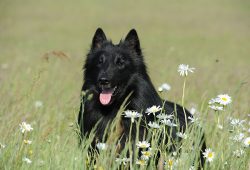The Belgian Shepherd (also known as the Belgian Sheepdog or Chien de Berger Belge) is a breed of medium-to-large-sized herding dog. It originated in [wiki base=”EN”]Belgium[/wiki] and is similar to other sheep herding dogs from that region, including the Dutch Shepherd, the German Shepherd, the Briard, and others. Four types have been identified by various registries as separate breeds or varieties: Groenendael, Laekenois, Tervuren, and Malinois.
Appearance
The Belgian Shepherd is a medium-to-large dog. Breed standards expect specimens to be athletic, and balanced in appearance. It has a squarish build.
The four varieties of Belgian Shepherd are distinguished by their coats and colours:
- The Groenendael (registered as Belgian Sheepdog by the American Kennel Club) is fairly long-haired, having a double coat of coarse, long guard hairs over softer, shorter down hairs. The overall coat texture is stiff, tight, and thick, developed to withstand the elements. Colouration is generally solid black, though sometimes with small white markings on the chest and toes.
- The Laekenois has wiry, overall fawn-colored hair but with intermingled white hairs. It lacks the black mask and ears of the Malinois, which is often also a light brown; however, most breed standards permit some darker shading on the muzzle, and on the tail.
- The Malinois is short-haired, tan to brown (usually mahogany), with hairs agouti-ticked with black to varying degrees. It has a black mask and ears, and sometimes has white markings on the toes and chest.
- The Tervuren is found in the same colour range as the Malinois, but may lean toward grey or sable (not permitted in all standards), and has long hair, forming a double coat like that of the Groenendael. It also sometimes has white markings on the toes and chest.
Temperament
Belgian Shepherd Dogs are described as highly intelligent, alert, sensitive to everything going on around them and form very strong relationship bonds. They are said to be loyal, intelligent, fun, highly trainable and well suited to family life. They should receive plenty of socializing as puppies and will benefit from regular activity and close interaction with people throughout their lifespan. Their herding heritage gives them a comparatively high energy level, and mental as well as physical exercise is necessary to keep a Belgian happy and healthy.
Health
Although a generally healthy variety of dog, Belgian Shepherds can have a susceptibility to hip dysplasia, epilepsy, gastric problems (including bloats and torsions), and some eye and skin problems. Notable health problems prevalent to the Malinois include [wiki title=”Cataract” base=”EN”]cataracts[/wiki], [wiki title=”Epilepsy” base=”EN”]epilepsy[/wiki], [wiki title=”Thyroid_disease” base=”EN”]thyroid disease[/wiki], [wiki title=”Progressive_retinal_atrophy” base=”EN”]progressive retinal atrophy[/wiki], [wiki title=”Hip_dysplasia_(canine)” base=”EN”]hip dysplasia[/wiki], and [wiki title=”Pannus” base=”EN”]pannus[/wiki], although these problems have been minimised through selective breeding.
Mortality
Median longevity of Belgian Shepherds (all varieties combined) in the 2004 UK survey, was 12.5 years, which is on the high side, both for purebred dogs in general and for breeds similar in size. The longest-lived of 113 deceased Belgians in the UK survey was 18.2 years. Leading causes of death were cancer (23%), cerebral vascular, i.e., stroke (13%), and old age (13%).
Morbidity
Belgian Shepherds are afflicted with the most common dog health issues (reproductive, musculoskeletal, and dermatological) at rates similar to breeds in general. They differ most notably from other breeds in the high incidence of seizures and/or epilepsy.
Belgian Shepherd. (2016, November 11). In Wikipedia, The Free Encyclopedia. Retrieved from https://en.wikipedia.org/w/index.php?title=Belgian_Shepherd&oldid=748992476


